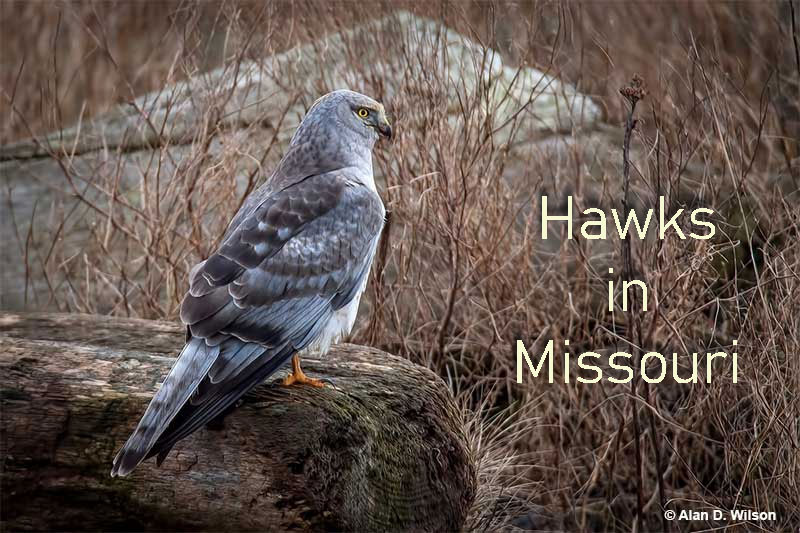
Missouri has beautiful woodlands, rolling farmlands, and lots of hawks! Visit, take a drive, or go for a walk in “The Show Me State” and you will see hawks in Missouri.
In Missouri, hawks soar overhead, perch in roadside trees, and even hunt birds in backyard feeders.
How many hawks have you seen in Missouri? We bet you’ve seen a lot but how many could you identify? Learn how to identify the hawks of Missouri in this article!
On this page
Most Common Hawks in Missouri
According to eBird data, eleven species of hawks have been seen in Missouri. Seven different species of hawks are commonly seen, while four other species are rare visitors to the state.
To make a reliable list of hawks in Missouri, we used eBird data and arranged the most common ones first and the least common ones last.
Hawks aren’t the easiest birds to identify but, with good looks and focusing on the right field marks, we can put a name on most of the hawks we see.
To help, our list also includes information about identification and behavior!
Red-tailed Hawk
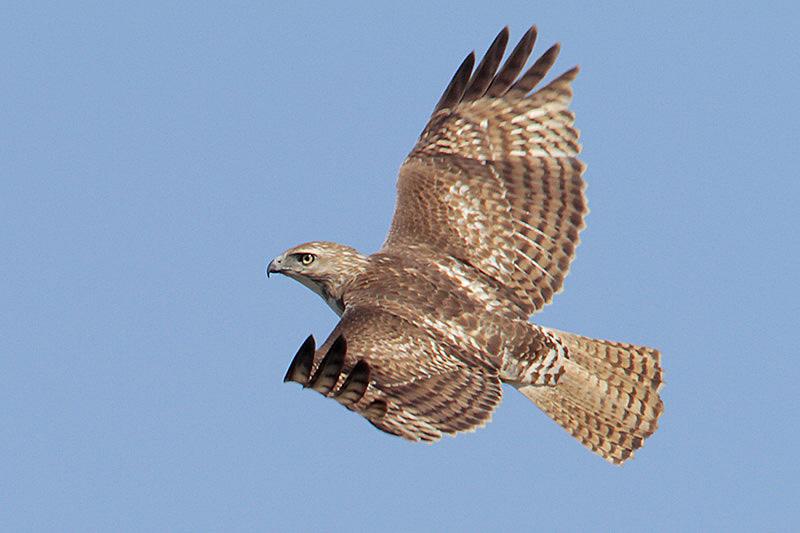
Red-Tailed hawk (Juvenile) © Greg Lavaty.
Scientific name: Buteo jamaicensis
Speed: 20-40 miles per hour
Length & Weight: 19 inches, 2.4 pounds
Wingspan: 49 inches
Call: “keeeyah!”
The Red-tailed Hawk is a big and bulky hawk with dark brown upperparts and long, broad wings. Adults have a broad reddish tail and both sexes are similar (although females are larger than males).
In the east, adults have pale underparts with dark marks on their belly but western birds can be dark brown, buff, or reddish-brown below. Young birds have brown tails with darks barring.
In flight, all Red-tailed Hawks show a large, somewhat square-shaped, pale area near the tips of their wings.
This species preys on a variety of small animals including squirrels, rats, snakes, and birds. It catches prey by swooping down from a perch or from soaring flight.
Red-tailed Hawks build a messy stick nest high in a tree or on the ledge of a building.
They use a wide range of habitats in Alaska and the USA, much of Canada, Mexico, the Caribbean, and parts of Central America.
Key Identifications:
- Large, hefty hawk with a reddish tail and dark marks on its pale belly.
- Preys on small mammals, snakes, and birds.
- Builds a bulky stick nest high in a tree.
- Makes loud, jay-like, ringing calls, “keeeyah!”.
Red-shouldered Hawk
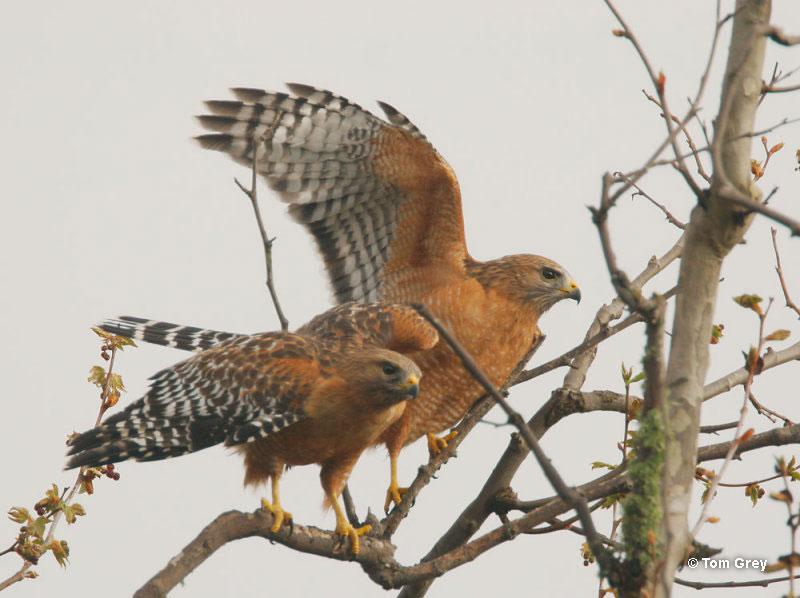
© Tom Grey
Scientific name: Buteo lineatus
Speed: 18-34 miles per hour
Length & Weight: 17 inches, 1.4 pounds
Wingspan: 40 inches
Call: “keer keer keer keer keer!”
The Red-shouldered Hawk is a medium-sized hawk with reddish-orange underparts and shoulder, and black and white on its wings and tail.
Both sexes are similar but as with most raptors, females are larger than males. Young birds are brown above and have dark streaks on pale underparts.
In flight, all ages of this hawk species are best recognized by their longish, black and white tail and long wings with a pale crescent-shaped mark near the tip of the wing.
Red-shouldered Hawks prey on snakes, lizards, frogs, and other small animals. They forage by waiting on a perch and then swooping down to catch the animal on the ground.
These birds of prey live in a variety of woodland habitats in southeastern Canada, the eastern USA, including Missouri, California, southeastern Oregon, and Baja California, Mexico.
Key Identifications:
- Medium-sized, colorful hawk with reddish-orange underparts and shoulder, and black and white upperparts and tail.
- Forages for snakes and other small animals on the ground in woodland habitats.
- Builds a bulky stick nest high in a tree.
- Makes loud, jay-like, ringing calls, “keer keer keer keer keer!”
Northern Harrier
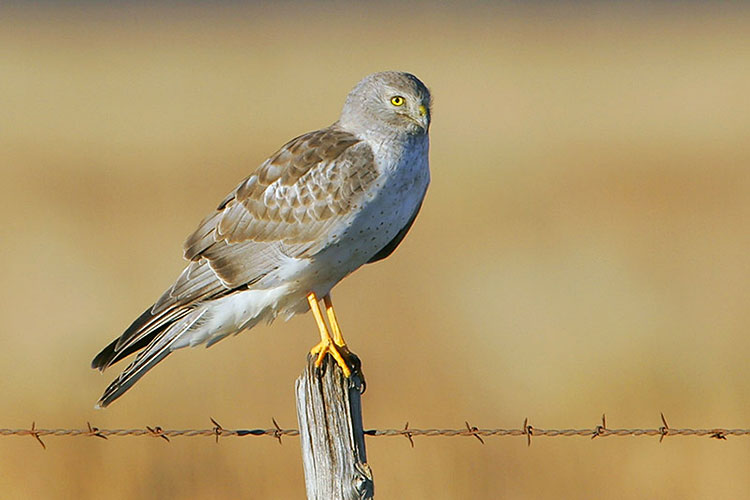
Scientific name: Circus hudsonius
Speed: 21-38 miles per hour
Length & Weight: 18 inches, 15 ounces
Wingspan: 43 inches
Call: “che che che che che che”
The Northern Harrier is a fair-sized, unique hawk with long wings, a long tail, and a white rump. Adult males have gray upperparts, head, and breast. They also have some pale brown spotting on their underparts and black tips on their wings.
Females are dark brown above and have dark brown streaks on pale underparts. Young birds are also dark brown above but have deep orange-buff underparts.
All Northern Harriers have a white rump and glide low over the ground on long wings held in a “V” shape.
This species preys on small animals caught on the ground, sometimes after hovering.
It uses grass and other vegetation to make a shallow, platform nest on the ground, in thick wetland or grassland areas.
Northern Harriers breed in open grasslands in Alaska, Canada, California, and the northern and central USA, including Missouri. They winter in much of the USA, Mexico, and rarely to northern South America.
Key Identifications:
- Distinctive long-winged, long-tailed hawk with a white rump.
- Glides low over the ground to catch rodents and other small animals in marshes and other open grassy habitats.
- Builds a platform nest on the ground, in tall thick grass.
- Makes a repetitive, woodpecker-like call, “che che che che che che”
Cooper’s Hawk
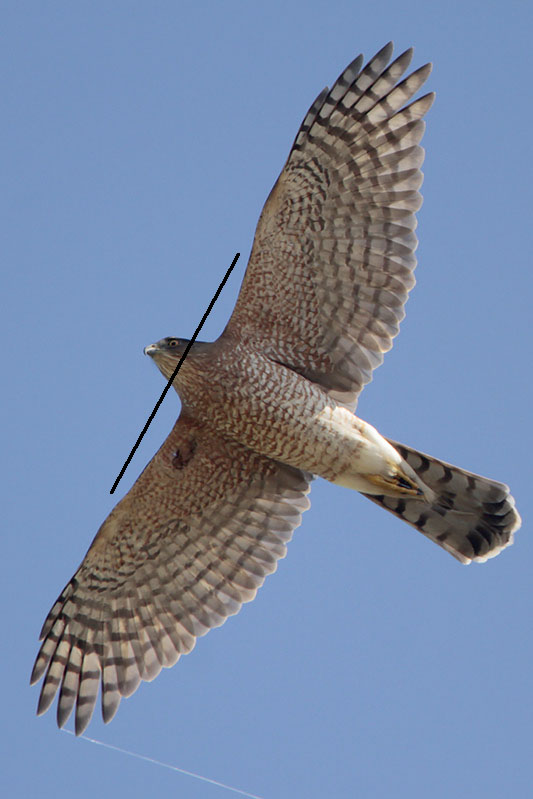
Scientific name: Accipiter cooperii
Speed: 21-55 miles per hour
Length & Weight: 16.5 inches, 1 pound
Wingspan: 31 inches
Call: “kek kek kek kek kek!”
The Cooper’s Hawk is a fair-sized hawk with a long, rounded tail and a blocky, square-shaped head. Adults are blue-gray above and have orange barring below.
Both sexes look similar although females are larger. They also often show a dark cap, have pale grayish on their face and side of the neck, and dark banding on their tail.
Young birds are shaped like adults but are dark brown above, have paler brown on the head, and fine dark streaking on pale underparts.
In flight, this species uses its rounded wings to make a few deep flaps followed by a brief glide.
The Cooper’s Hawk preys on songbirds and other medium-sized birds, and small mammals. It usually catches them on the ground and frequently attacks birds at bird feeders.
Cooper’s Hawks build a bulky stick nest high in a tree and often nest in parks.
This species lives in a variety of wooded and semi-wooded habitats in southern Canada, most of the USA, including Missouri, and in parts of Mexico.
Key Identifications:
- Fair-sized hawk with orange barring below, blue gray above, and a long rounded tail.
- Preys on small mammals and starlings and dove-sized birds in woodlands, parks, and towns.
- Builds a bulky stick nest high in a tree.
- Usually quiet but when breeding, it makes a loud barking call, “kek kek kek kek kek!”
Sharp-shinned Hawk
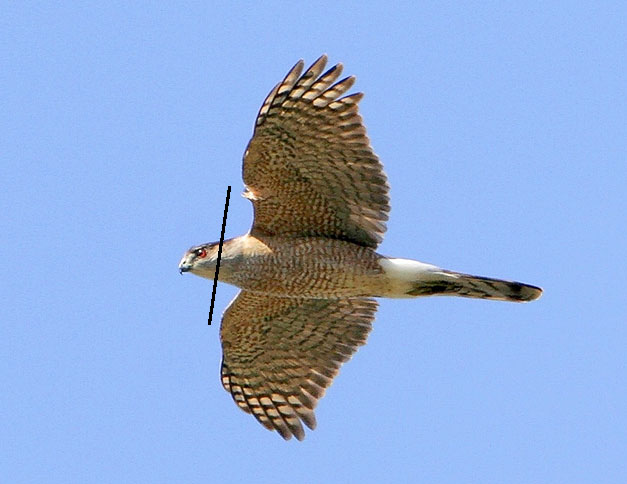
Scientific name: Accipiter striatus
Speed: 16-60 miles per hour
Length & Weight: 11 inches, 5 ounces
Wingspan: 23 inches
Call: “kew kew kew kew kew kew kew kew”
The Sharp-shinned Hawk is a small hawk with a long, rectangular tail and rounded wings. Adults have blue-gray upperparts, orange barring on their underparts, and dark bands on their tail.
Females are larger than males and young birds are dark brown above with thick brown streaks on pale underparts.
This species flies with several quick wing beats followed by brief glides. When flying, its head doesn’t stick out as much as a Cooper’s Hawk and it shows a square-tipped tail.
The Sharp-shinned Hawk preys on small birds up to the size of an American Robin. It mostly catches birds around the same size as sparrows, warblers, and vireos by quickly flying and catching them in vegetation.
This hawk builds a bulky stick nest high in a conifer.
Sharp-shinned Hawks live in wooded habitats in Alaska, much of Canada and the USA, Mexico, parts of Central America, the Caribbean, and parts of South America. They are common hawks in Missouri.
Key Identifications:
- Small hawk with rounded wings and a long, rectangular tail.
- Preys on small birds in woodland habitats.
- Builds bulky stick nest high in a conifer.
- Usually quiet but on breeding grounds makes falcon-like, repeated ringing calls “kew kew kew kew kew kew kew kew”.
Broad-winged Hawk
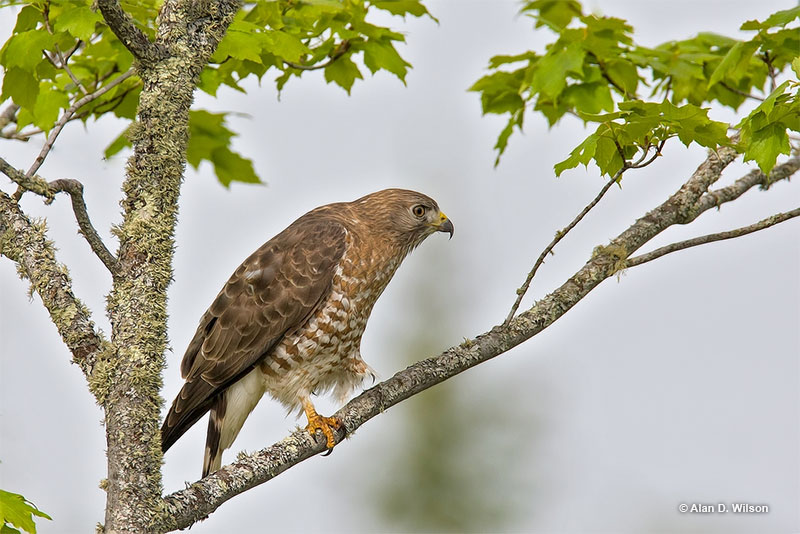
Scientific name: Buteo platypterus
Speed: 20-40 miles per hour
Length & Weight: 15 inches, 14 ounces
Wingspan: 34 inches
Call: “sipeeeeeeeee”
The Broad-winged Hawk is a smallish raptor around the same size as a crow. Adults are dark brown above, have dark, reddish-brown barring below, and a broad tail with a few wide, white bands.
Both sexes look the same and also have a thick dark mark on each side of their throat, although females are larger. Young birds have dark brown streaks on pale underparts.
In flight, this species often soars, shows a broad black and white tail, and has long wings shaped like a “paring knife” that also have a dark trailing edge.
This raptor preys on voles, amphibians, insects, and other small animals. It catches food by waiting on a perch and then quickly swooping down to the ground.
Broad-winged Hawks make a bulky stick nest high in a tree.
This small hawk breeds in forest habitats in central and southeastern Canada and much of the eastern USA. It winters in southern Florida and Mexico south to Bolivia.
Key Identifications:
- Chunky, smallish, crow-sized hawk with a few white bands on its tail and underparts with brown barring or streaks.
- Preys on insects and small animals in woodland habitats.
- Builds a bulky nest high in a tree.
- Makes a high-pitched call, “sipeeeeeeeee”
Rough-legged Hawk
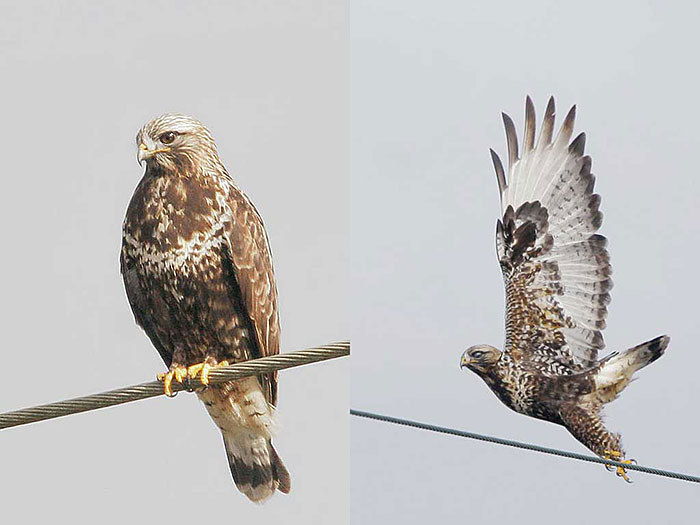
Photograph © Tom Grey
Scientific name: Buteo lagopus
Speed: 22-28 miles per hour
Length & Weight: 22 inches, 1.3 to 3.6 pounds
Wingspan: 53 inches
Call: “reeaaaauh!”
The Rough-legged Hawk is a long-winged hawk with a black and white tail. There are two color morphs; both with broad white patches near dark wing tips, and a longish pale tail with a broad black tip.
Pale females and juveniles are pale gray-brown with a black belly and black “wrists” in their wings. Pale adult males are more cold gray, have less black on their belly, and heavily streaked breasts.
Dark females and juveniles are dark brown except for their tail and flight feathers. Dark adult males are black except for their flight feathers and tail.
In flight, this species holds its wings in a shallow “V”.
Rough-legged Hawks soar and hover over open fields where they prey on voles and other small animals.
The Rough-legged Hawk breeds in tundra in Alaska, northern Canada, and northern Eurasia, and winters in open fields in southern Canada, the northern, central, and western USA, including Missouri, and Europe and Asia.
In Missouri, they are migrants. Rough-legged Hawks can be seen in the winter months, but when the time is right, migration to their breeding grounds is due.
Key Identifications:
- Big hawk with a longish black and white tail, and long wings with broad white patches near the dark wing tips.
- Preys on rodents and other small animals in wide open habitats.
- Builds a big, bulky nest on cliffs and rocky outcroppings in tundra.
- Makes a loud, clear descending call, “reeaaaauh!”.
Rare Hawks in Missouri
Swainson’s Hawk
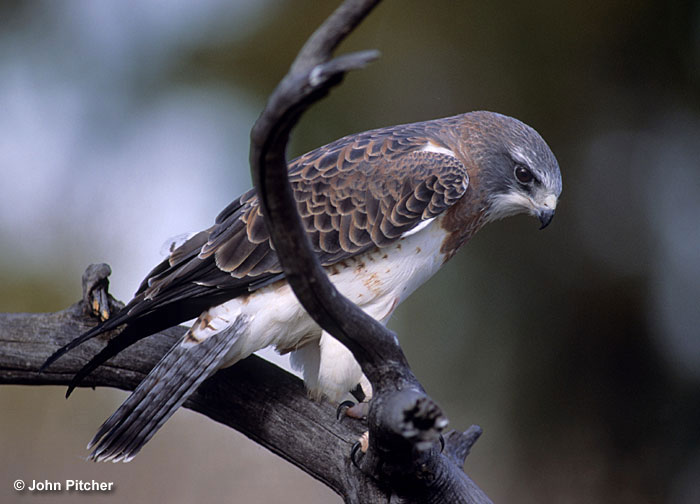
Scientific name: Buteo swainsoni
Speed: 15-60 miles per hour
Length & Weight: 19 inches, 1.9 pounds
Wingspan: 51 inches
Call: “eeeah!”
The Swainson’s Hawk is a big hawk with dark-brown upperparts, long, pointed wings with dark flight feathers, and a broad tail with fine dark barring and a dark tip. Males and females are similar although females are larger.
Adults can have a white throat, front, wing linings, and underparts with a red-brown breast. They can also have a white throat and front, and reddish brown underparts and wing linings, or be entirely dark brown.
Young birds can have dark markings on pale underparts or be mostly dark below.
This species catches grasshoppers and small animals on the ground. It forages by soaring and then swooping down or walking on the ground.
It builds a bulky stick nest in a tree.
Swainson’s Hawks breed in grasslands, meadows, and other open habitats in central and western Canada and the USA, including Missouri. They migrate through the central USA and winter in grasslands in Argentina. A few also migrate through and winter in southern Florida.
Key Identifications:
- Large, long-winged hawk with dark flight feathers and a broad tail with fine dark banding and a dark tip.
- Feeds on insects and small animals in prairies and other open habitats.
- Builds a bulky stick nest in a tree.
- Makes a loud, descending, single note, “eeeah!”.
Ferruginous Hawk
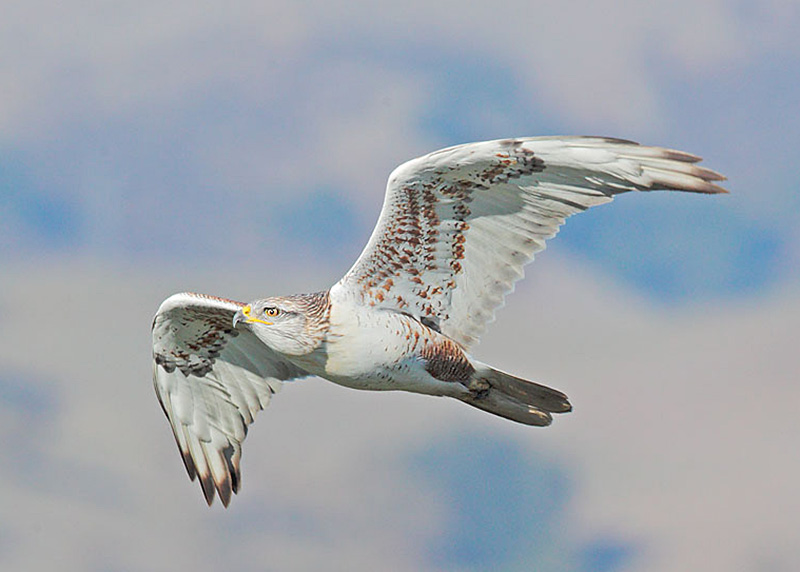
Photograph © Tom Grey.
Scientific name: Buteo regalis
Speed: up to 150 miles per hour
Length & Weight: 23 inches, 2.3 pounds
Wingspan: 55 inches
Call: “reeaaaauh!”
The Ferruginous Hawk is a big hawk with a pale tail, long wings, and feathered legs. There are two color morphs.
Adults can be white below with red-brown on their wing linings and flanks. They also have reddish-brown legs and are reddish-brown and pale gray above. Dark morphs are dark brown with a pale tail and pale flight feathers.
Juveniles are paler below and lack reddish-brown colors.
In flight, it soars with wings held in a shallow “V”. Pale primary patches are also visible on the upper sides of each wing.
The Ferruginous Hawk preys on prairie dogs and other mammals but can also catch waterfowl. It waits on the ground, low perch, or flying low and then snatching prey with its talons.
It builds a big, bulky stick nest in a lone tree, or on a rock outcropping or other structure.
This raptor lives in wide open habitats in south-central Canada, the western USA and northern Mexico. They are common hawks in Missouri.
Key Identifications:
- Big pale or dark hawk with long wings and a pale tail.
- Preys on prairie dogs, other mammals, and waterfowl in wide open habitats.
- Builds a big and bulky stick nest in an isolated tree or other structure.
- Makes a hoarse, descending call, “reeaaaauh!”.
Northern Goshawk
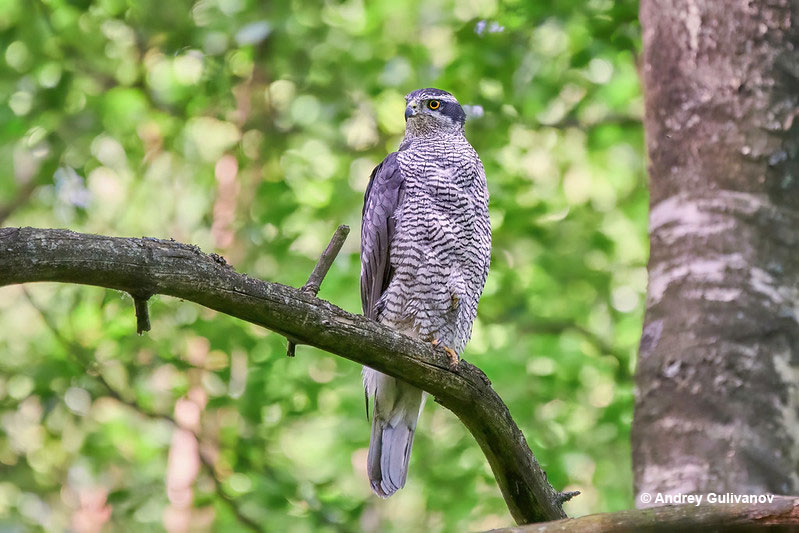
© Andrey Gulivanov
Scientific name: Accipiter atricapillus
Speed: 30-40 miles per hour
Length & Weight: 19 inches, 2 pounds
Wingspan: 40 inches
Call: “kip kip kip”
The Northern Goshawk is a large, hefty hawk with a long, banded tail, and rounded wings. Adults look similar, but females can be 25% larger. Both sexes are gray above and white below with fine gray barring. They also have a dark cap and cheek, red eyes, and a white eyebrow.
Young birds are dark brown above with some pale spotting, have pale eyebrows, uneven dark bands on their tail, and heavily streaked underparts.
In flight, Northern Goshawks make a few deep flaps followed by long glides.
This powerful raptor preys on squirrels, other small mammals, and grouse, woodpeckers, and many other mid-sized birds. They catch prey on the ground or by quickly flying through vegetation to grasp the unlucky animal with their talons.
This species builds a bulky stick nest high in a tree.
In North America, Northern Goshawks live in coniferous and other wild wooded habitats in Alaska, Canada, parts of the northern and western USA, including Missouri, and northern Mexico.
Key Identifications:
- Hefty, long-tailed hawk with gray plumage or brown, streaked plumage, and a white eyebrow.
- Preys on fair-sized birds and mammals in coniferous forest habitats.
- Builds a bulky, stick nest high in a tree.
- Makes a repeated call, “kip kip kip kip kip kip kip kip kip kip kip”.
Harris’s Hawk
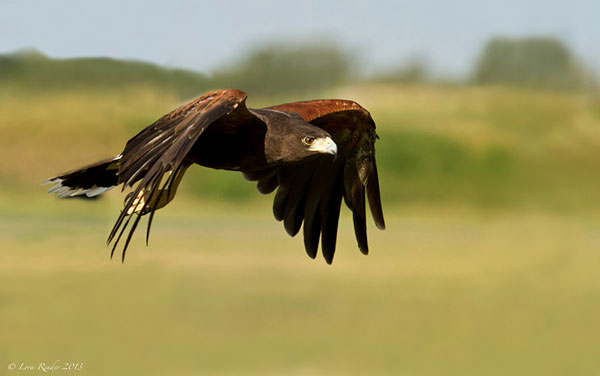
Scientific name: Parabuteo unicinctus
Speed: 22-28 miles per hour
Length & Weight: 20 inches, 1.5 pounds
Wingspan: 44 inches
Call: “kleeah, klee, klee, klee, klee”
The Harris’s Hawk is a large, dark brown and reddish-brown hawk with a long black and white tail, and much yellow on the base of its beak. Males and females look alike, although females are larger.
Young birds are like adults but have a paler tail, paler flight feathers, and dark streaks on their underparts.
This hawk soars and makes slow, deep flaps on fairly long, broad wings.
This species feeds on a variety of medium-sized mammals, reptiles, and birds. It catches them by swooping down from a perch or from low flight.
The Harris’s Hawk builds a bulky stick nest in a large cactus or a tree.
Harris’s Hawks live in the desert and subtropical habitats from Texas and parts of the southwestern USA south to Argentina.
Key Identifications:
- Large, dark brown and reddish-brown hawk with a long black and white tail.
- Preys on rabbits and other small animals and birds.
- Builds a bulky stick nest in a large cactus or other sturdy structure.
- Makes ringing, rather high-pitched calls, “kleeah, klee, klee, klee, klee”.
Hawks in Missouri – Frequently Asked Questions
What hawks are found in Missouri?
Seven species of hawks are commonly found in Missouri along with four other rarely seen species. The most common hawk species in Missouri are the Red-tailed Hawk, Red-shouldered Hawk, and the Northern Harrier.
Are there other raptors in Missouri?
Missouri has a large variety of birds of prey, but hawk populations are the largest. Eagles are common – especially Bald Eagles, but some Golden Eagles can be spotted too. The only falcon that can be seen year-round are Peregrine Falcons.
What do Missouri hawks eat?
Missouri hawks eat rodents, small birds, and other small animals.
Do Missouri hawks migrate?
Yes, at least four species of Missouri hawks migrate. The Broad-winged Hawk migrates to Central and South America.
What is the small hawk-like bird in Missouri?
The small hawk-like bird in Missouri could be a Sharp-shinned Hawk or an American Kestrel. Both of these small raptors are just a little bit larger than an American Robin.
Read next – Owls in Missouri | Woodpeckers in Missouri

